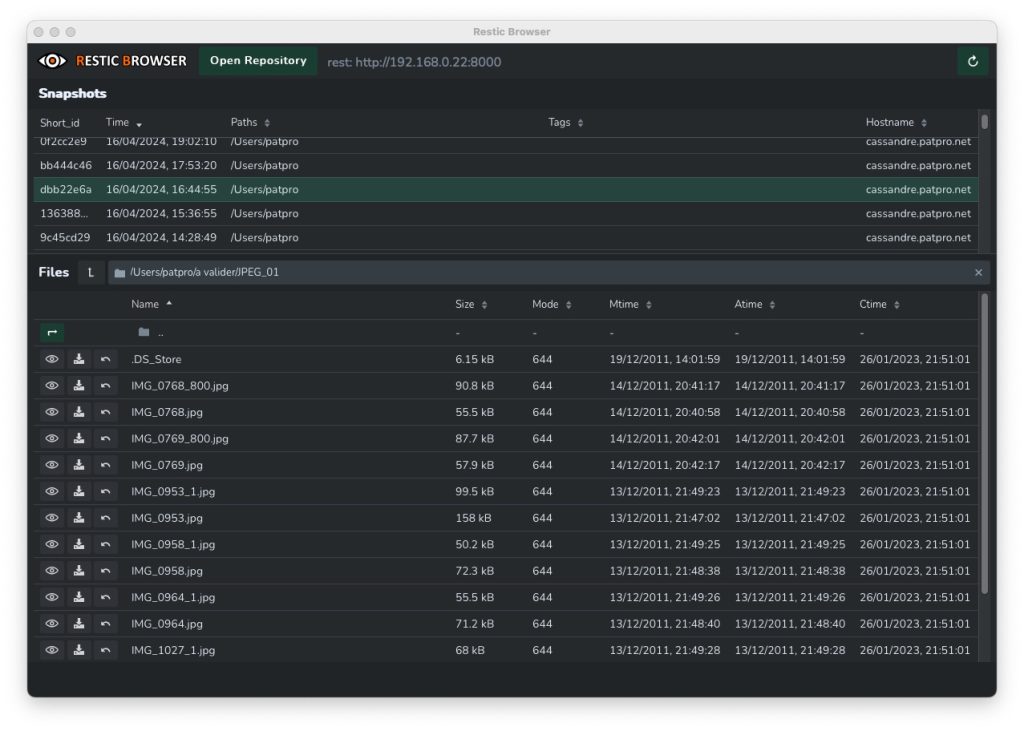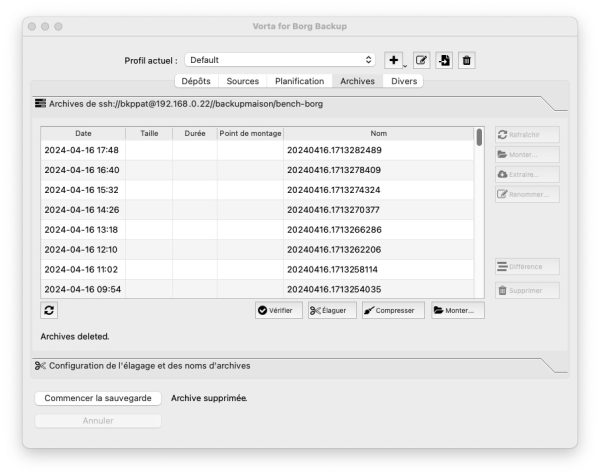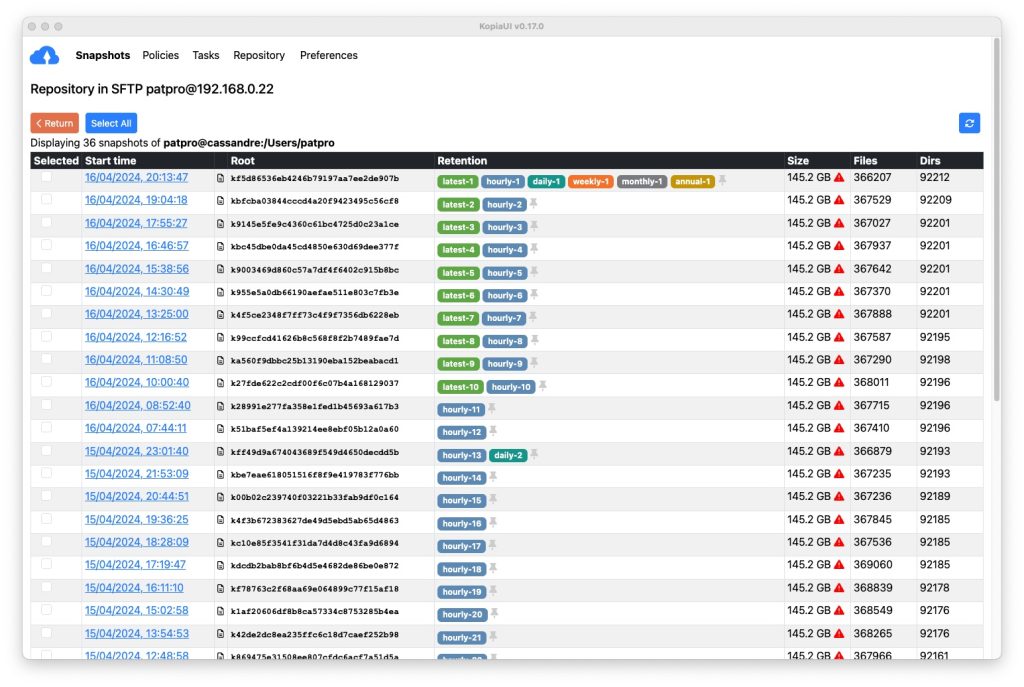In this final article, I'm going to talk about the little extras that can't be included in my comparison as a measurable criterion.
I'm going to talk briefly about graphical interfaces, because for some users, this can make a big difference. Application sizes are given for the macOS version.
Of the three programs, Restic has the richest and least mature ecosystem in terms of graphical user interfaces. There are several of them, but they're all independent projects more or less in the alpha or beta phase, and they don't all offer the same level of functionality.
I have only tested Restic Browser. This lightweight graphical interface (13 MB) is designed solely for browsing snapshots and restoring files. The application works perfectly and does exactly what's expected of it. Nothing to say, except that it's a very pleasant complement to a stand-alone backup script running on the user's machine.

Borg's main GUI project is called Vorta. It's a full-featured application that lets you fully configure backups, with scheduling, exclusion lists, compression parameters and more. This software weighs in at around 127 MB, but offers full functionality (configuration, scheduling, cleanup, restore, repository verification, etc.). On macOS, you'll just need to install the Fuse drivers to mount a remote archive locally. As Borg works without a configuration file, and without storing its configuration on the repository, it is unfortunately impossible for Vorta to retrieve the settings for backups, which are done on the command line. It can, however, connect to an existing repository, list archives, perform backups, restores and all other tasks. Just bear in mind that Vorta has no knowledge of the parameters you pass to Borg in any backup script. It's therefore a program that's best suited to stand-alone use: you set your backup/restore parameters directly in Vorta, and Vorta takes care of the rest.

In contrast, Kopia offers a totally unified backup experience between its command-line client and its KopiaUI interface. All backup, cleanup and other parameters are configured in a policy accessible to both environments. This means you can switch from the command line to the GUI, no questions asked. Still, KopiaUI weighs in at 313 MB and offers far less advanced functionality than Vorta. It is impossible, for example, to launch a verification task on a snapshot, or to make a comparison between two snapshots. Note that it is possible to display this user interface without even installing KopiaUI: in fact, kopia's command line integrates a server mode that displays exactly the same graphical interface in a Web browser.

In addition to graphical interfaces, there are "wrappers" that facilitate the use of Restic and Borg. For Kopia, this type of tool probably doesn't exist, or exists only marginally, due to its integrated management of backup policies. On the other hand, Restic and Borg do not benefit from complete configuration management, and these command-line "wrappers" can be very useful. I haven't tested one for Restic, but I've been using Borgmatic for some of my machines for several years. Using YAML files, this tool allows you to configure all backup, retention and other parameters.
Example of use:
@daily borgmatic -v 1 create --files prune ; borgmatic list 0 2 16-23 * 2 borgmatic -v 1 check 0 2 16-23 * 3 borgmatic -v 1 compact
kopia's server mode and Restic's REST-server mode make it easy to manage a multi-user backup repository. This is a type of operation that is not trivial to reproduce with Borg, as the latter requires users to be provided with SSH access. Of course, SSH access can be limited (must be!), but this entails management complications that go far beyond a simple login and password, as is the case with Restic and Kopia.
In multi-user mode, Kopia is superior to the REST-server. In fact, the latter only allows users to be managed via an .htpasswd file, whereas Kopia provides rather elaborate management of users and their access authorizations. I couldn't find any mention in the Restic documentation of its ability to share duplication when several users are backing up their data on the same server. However, this is an official feature of Kopia in server mode. It's important to note that this raises questions in terms of security. If users share a common repository, they can theoretically retrieve data from other users. Fortunately, this is only possible if the user knows the 256-bit hash corresponding to the file he wishes to retrieve. On the other hand, it could very well be used intentionally by Alice to share with Bob a file she has saved via Kopia. All Alice has to do is transmit the 256-bit hash to Bob, who can then restore it via his Kopia client.
Of these three backup solutions, only Borg doesn't offer a wide range of storage modes, including several in cloud environments that don't require deployment of the application. It is no doubt because of this difference that the market offers little or no storage for Restic or Kopia-based backups. There are a few commercial services offering storage for Borg backup repositories, such as rsync.net or borgbase.com. The latter is the only one, as far as I know, that also offers Restic backup hosting. I haven't found anything for Kopia, so don't hesitate to correct me in the comments. There are, however, a few turnkey solutions based on consumer NAS boxes, such as QNap, for which these three applications have been implemented.
To conclude this series of articles, I'll summarize the qualification tables for all three products here.
| Borg | Kopia | Restic | |
|---|---|---|---|
| Portability | - | + | + |
| Storage options | - | + | + |
| Transport options | - | + | + |
| Multi-client storage | - | + | + |
| backup duration | - | + | - |
| network volume | + | + | - |
| retention management | + | - | + |
| Restore duration | - | - | + |
| Network volume | - | - | + |
| Cleanup duration | + | + | - |
| Network volume | - | + | + |
| Check duration | + | - | + |
| Local cache size | + | - | - |
| Final score | 5 | 8 | 9 |
Please note that functional coverage (portability, storage and transport options, etc.) weighs heavily in the final score. If these aspects are of no importance to you, the final score will be significantly altered.
My analysis of the Borg, Kopia and Restic solutions is now complete. Unfortunately, I'm no further ahead than before, as these solutions are relatively equivalent and all have attractive aspects. I still haven't decided whether to replace Borg with something else and, if so, with what.



